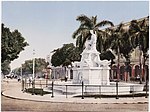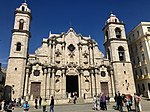Hotel Saratoga explosion
2022 disasters in North America2022 in Cuba21st century in HavanaDisasters in HavanaExplosions in 2022 ... and 2 more
Explosions in CubaMay 2022 events in North America
On May 6, 2022, Hotel Saratoga, a luxury hotel in the Old Havana municipality in the city of Havana, Cuba, suffered a suspected gas explosion that damaged large portions of the building as well as surrounding infrastructure. 47 people died and 52 were injured. The hotel was undergoing renovations and there were no guests; however, there were fifty-one workers inside.
Excerpt from the Wikipedia article Hotel Saratoga explosion (License: CC BY-SA 3.0, Authors).Hotel Saratoga explosion
Paseo de Martí (Paseo del Prado), Havana
Geographical coordinates (GPS) Address Nearby Places Show on map
Geographical coordinates (GPS)
| Latitude | Longitude |
|---|---|
| N 23.133611111111 ° | E -82.358055555556 ° |
Address
Paseo de Martí (Paseo del Prado)
Paseo de Martí (Paseo del Prado)
10000 Havana (Prado)
Havana, Cuba
Open on Google Maps











